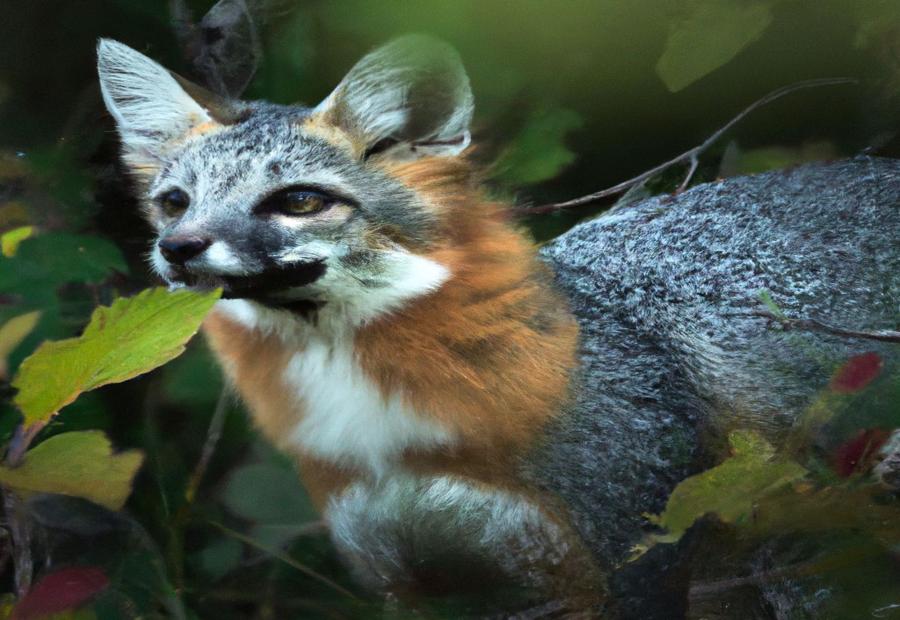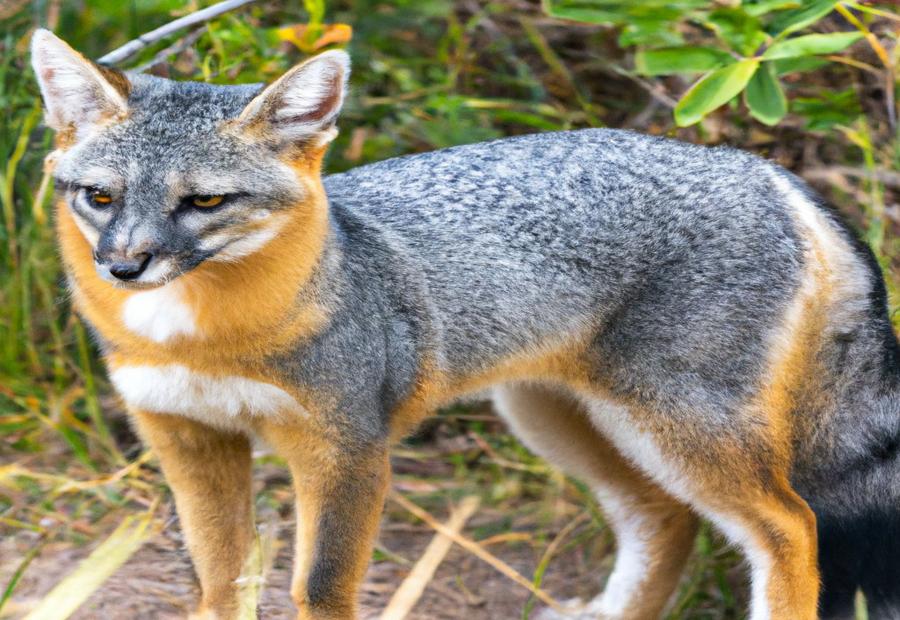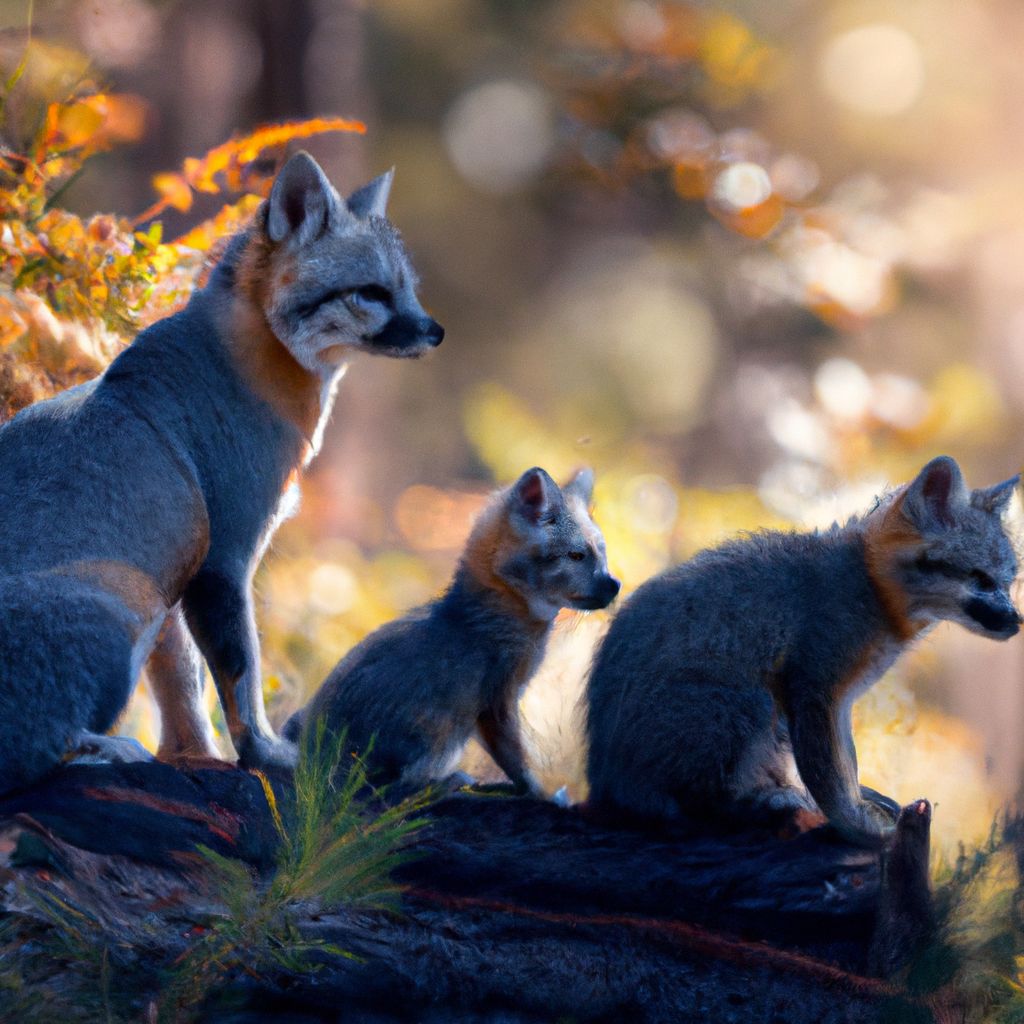The Gray Fox, known for its unique appearance and behavior, plays a significant role in ecotourism. Ecotourism, or nature-based tourism, focuses on appreciating and preserving natural environments and their inhabitants. The Gray Fox, a fascinating creature, has captured the attention of ecotourists worldwide. In this article, we will explore the importance of the Gray Fox in ecotourism and its ecological impact, conservation efforts, viewing opportunities, and the future of Gray Foxes in relation to sustainable ecotourism practices.
The Gray Fox holds a crucial position in the ecotourism industry for several reasons. Its presence in various ecosystems contributes to their biodiversity and ecological balance. Ecotourists are attracted to the Gray Fox for its elusive nature, adaptability, and the opportunity to observe its behavior in the wild. This leads to increased awareness about the importance of conservation and fosters a sense of responsibility towards preserving the natural habitats of the Gray Fox and other wildlife species.
The Gray Fox’s impact on the ecosystem is noteworthy. It plays a vital role in seed dispersal and controlling population levels of small mammals, rodents, and insects. By consuming these species, the Gray Fox helps maintain a balanced ecosystem, preventing overpopulation and its subsequent impact on other flora and fauna. Understanding the ecological significance of the Gray Fox is crucial for developing effective conservation strategies and promoting ecotourism practices that minimize harm to its habitat.
Conservation efforts for the Gray Fox are essential due to the threats it faces. Habitat loss, fragmentation, human disturbances, and hunting pose significant challenges to their survival. Organizations and researchers are actively engaged in studying the Gray Fox population, monitoring their habitat, and implementing conservation measures to protect and restore their numbers. These efforts include promoting sustainable land-use practices, educating local communities, and establishing protected areas to safeguard the Gray Fox’s natural habitat.
Ecotourists interested in observing the Gray Fox in its natural habitat can explore specific regions known for their Gray Fox populations. By visiting designated areas with experienced guides, ecotourists can have a higher chance of encountering and appreciating these magnificent creatures without causing harm or disturbance. Responsible ecotourism practices, such as following designated trails and adhering to viewing guidelines, are crucial for minimizing human impact and preserving the Gray Fox’s natural behavior.
In the future, promoting sustainable ecotourism involving Gray Foxes requires collaborative efforts. This includes the involvement of local communities, conservation organizations, and governmental bodies in promoting responsible tourism practices. Conservation education initiatives, research programs, and community-based tourism activities can contribute to the long-term sustainability of Gray Fox populations and their habitats.
By understanding the significance of the Gray Fox in ecotourism, its ecological impact, conservation efforts, and responsible viewing opportunities, we can work towards ensuring the future of Gray Foxes and the preservation of their habitats through sustainable ecotourism practices.
– The Gray Fox plays a significant role in ecotourism by attracting visitors to natural areas and generating economic benefits. – The Gray Fox contributes to the ecosystem by controlling rodent populations and dispersing seeds, promoting biodiversity. – Threats such as habitat loss and human disturbance pose challenges to the survival of the Gray Fox, warranting conservation efforts. – Responsible ecotourism can support Gray Fox conservation by ensuring minimal disturbance and respecting their natural habitat. – Promoting sustainable ecotourism involving Gray Foxes requires a collaborative effort involving stakeholders and implementing conservation measures.
Contents
- 1 The Role of the Gray Fox in Ecotourism
- 2 The Ecological Impact of the Gray Fox
- 3 The Gray Fox and Conservation
- 4 The Gray Fox: Viewing Opportunities and Responsible Ecotourism
- 5 The Future of Gray Foxes and Ecotourism
- 6 Frequently Asked Questions
- 6.1 What is the role of the gray fox in ecotourism?
- 6.2 What are some characteristics of the gray fox?
- 6.3 How does climate change influence the gray fox and sustainable travel?
- 6.4 What are some emerging markets that support sustainable travel?
- 6.5 How can tourists contribute to sustainable travel and authentic local experiences?
- 6.6 What are the main challenges in promoting sustainable travel and raising awareness?
The Role of the Gray Fox in Ecotourism
The Role of the Gray Fox in Ecotourism
The gray fox plays a crucial role in ecotourism, attracting visitors and contributing to the local economy.
1. Habitat Preservation: Gray foxes are key indicators of the need for habitat conservation. Ecotourists are drawn to locations where they can observe these foxes in their natural environment, highlighting the importance of protecting biodiversity.
2. Unique Wildlife Viewing Experience: Ecotourists actively seek opportunities to observe and connect with unique wildlife species. The gray fox offers an exciting experience for nature enthusiasts, renowned for its elusive nature and ability to adapt. Sightings of these foxes can be a highlight of ecotourism trips, fostering a deeper appreciation for wildlife.
3. Role in Ecosystem: Gray foxes play a vital role in maintaining ecological balance. They help control populations of small mammals and serve as indicators of ecosystem health. By understanding the gray fox’s position in the food chain, ecotourists can gain insights into the interconnectedness of species and the significance of preserving habitats.
4. Educational Opportunities: Ecotourism involving the gray fox provides valuable educational benefits. Local guides and experts can offer informative presentations and tours, sharing insights into the behavior, habitat requirements, and conservation efforts related to the gray fox. This empowers visitors to become advocates for the protection of these species and their habitats.
5. Economic Impact: The gray fox contributes to the economic well-being of local communities through ecotourism. Visitors spend money on accommodations, tours, transportation, and other services, stimulating local businesses and creating employment opportunities. Ecotourism centered around the gray fox actively supports sustainable development and conservation initiatives.
Recognizing the important role of the gray fox in ecotourism promotes its conservation, supports local communities, and cultivates a greater appreciation for the natural world.
Why is the Gray Fox Important in Ecotourism?
The gray fox is vital in ecotourism for various reasons. It contributes to biodiversity and enhances the natural beauty, drawing tourists to ecotourism destinations. Visitors often desire to witness the gray fox in its natural habitat, enriching the unique experience of ecotourism.
The gray fox plays a crucial role in maintaining ecosystem balance by regulating populations of small mammals as both a predator and scavenger. This prevents overpopulation and mitigates negative effects on vegetation and other animal species, ensuring a healthy and flourishing ecosystem.
Moreover, the gray fox offers educational opportunities in ecotourism. Tourists can acquire knowledge about the species’ behavior, adaptations, and its position in the food chain. This awareness raises consciousness about the significance of preserving natural habitats and ecosystems, thereby promoting conservation efforts.
The presence of the gray fox can stimulate local economies that rely on ecotourism. Tourists contribute to the revenue of local businesses such as accommodations, tour operators, and restaurants, which in turn support conservation initiatives and the protection of the gray fox’s habitat.
The Ecological Impact of the Gray Fox

Photo Credits: Foxauthority.Com by Vincent Allen
The gray fox, with its ecological impact, plays a vital role in its habitat. As a predator, the gray fox contributes to the ecosystem by helping to maintain balance in the population of small mammals and regulating their numbers. This, in turn, allows for the growth of healthy vegetation and reduces the risk of overgrazing.
In addition to its role as a predator, the gray fox also serves as a seed disperser. When it consumes fruits, the gray fox not only eats the flesh but also swallows the seeds. These seeds are then transported to different areas through the fox’s feces, aiding in the dispersal and colonization of plants.
Furthermore, the gray fox enhances soil health through its burrowing activities. By digging burrows for shelter and raising young, the gray fox aerates the soil and improves its structure. This has a positive impact on water infiltration, nutrient availability, and the overall growth of plants, ultimately enhancing ecosystem productivity.
Lastly, the gray fox serves as prey for larger predators such as bobcats and coyotes. By sustaining the populations of these larger predators, the gray fox promotes biodiversity within the ecosystem.
Overall, the ecological impact of the gray fox is significant and encompasses its role as a predator, seed disperser, soil enhancer, and prey for larger predators.
How Does the Gray Fox Contribute to the Ecosystem?
How Does the Gray Fox Contribute to the Ecosystem?
The Gray Fox plays a significant role in the ecosystem by contributing to biodiversity, controlling prey populations, and serving as a keystone species.
1. Biodiversity: The Gray Fox contributes to the ecosystem by hunting a variety of small mammals, birds, and reptiles, thus promoting biodiversity. By keeping these populations in check, it helps maintain a balanced ecosystem and prevents overpopulation of any one species.
2. Prey population control: As a predator, the Gray Fox helps control rodent, rabbit, and other small animal populations. By regulating these numbers, it helps maintain the balance between predators and prey, thereby controlling the wildlife rehabilitation population.
3. Keystone species: The Gray Fox acts as a keystone species, meaning its presence has a disproportionate impact on the ecosystem. It plays a crucial role in maintaining the ecosystem’s structure and function. Its activities as a predator affect the distribution and abundance of other species in its habitat, making it a keystone species.
4. Habitat modification: The Gray Fox contributes to the ecosystem through its behaviors. It creates dens in trees or underground, which provide shelter for other animals. The fox’s digging habits also promote healthy plant growth by aerating the soil, thereby modifying the habitat.
Conserving the Gray Fox and its habitat is important to ensure the ecosystem’s continued functioning. This can be achieved through habitat preservation, protection from hunting or trapping, and raising awareness about the species’ importance. Promoting sustainable ecotourism involving the Gray Fox can encourage conservation efforts and contribute to the long-term preservation of this valuable species.
The Gray Fox and Conservation
The conservation of the gray fox is crucial to ensure its survival in its natural habitat. Active efforts must be made to protect and preserve their populations. Here are key aspects to consider regarding the conservation of the gray fox:
1. Preserve habitat: It is important to protect and preserve the natural habitat of the gray fox for their survival. By maintaining forests, woodlands, and brushy areas, we can ensure that they have sufficient space and resources to thrive.
2. Avoid habitat fragmentation: Fragmentation has a negative impact on gray fox populations. To maintain connectivity between different parts of their habitat, it is essential to prioritize land-use planning and minimize fragmentation.
3. Minimize human-wildlife conflict: Responsible behavior should be promoted to reduce conflicts with gray foxes. This includes proper waste management, refraining from feeding wildlife, and preventing the spread of diseases that could harm gray fox populations.
4. Implement education programs: Educating the public about gray fox conservation and their role in maintaining ecosystem balance is crucial. Raising awareness cultivates a sense of responsibility for their conservation.
5. Monitor and research: Regular monitoring and research should be conducted to gather information about gray fox populations, habitats, and threats they face. This data will inform effective conservation strategies and identify areas needing immediate attention.
By actively implementing these measures, we can contribute to the long-term survival and well-being of gray foxes, ensuring their importance in our ecosystems.
What Threats does the Gray Fox Face?
What Threats does the Gray Fox Face?
The Gray Fox faces several threats that have a significant impact on its survival and population. These threats include habitat loss, urbanization, fragmentation of its habitat, road mortality, and predation.
One of the main threats to the Gray Fox is habitat loss. Human populations destroy or fragment the fox’s natural habitat, which limits their access to food and leads to a decline in the population.
Another threat is urbanization. Cities encroach upon the fox’s habitat, resulting in conflicts with humans and the displacement or death of the fox in urban areas.
Fragmentation of habitat is also a significant threat. Natural landscapes are divided into smaller patches, isolating Gray Fox populations and reducing their ability to find mates and maintain genetic diversity. This can ultimately lead to inbreeding and reduced fitness.
Road mortality poses a serious threat to the Gray Fox. As roads are constructed through their habitat, foxes are at risk of being hit by vehicles while crossing. This results in high death rates and has a negative impact on population numbers.
Lastly, predation is a constant threat. Gray Foxes are preyed upon by coyotes, bobcats, and mountain lions. The competition for resources and predation limit their survival and population growth.
To ensure the conservation of the Gray Fox, it is crucial to address these threats by preserving their habitat, creating wildlife corridors, reducing human-wildlife conflicts, and promoting responsible development practices. Prioritizing the protection of their habitat and minimizing disturbances can help secure the future of the Gray Fox.
What Conservation Efforts are in Place for the Gray Fox?
Conservation efforts play a vital role in the preservation of the gray fox population and their habitats. Various initiatives have been implemented to protect this species and ensure its survival:
1. Habitat preservation: Organizations are actively involved in conserving and safeguarding the natural habitats of gray foxes, such as forests and woodlands. These habitats are crucial for their survival and reproductive activities.
2. Reducing human-wildlife conflict: The focus of conservation efforts is to minimize conflicts between humans and gray foxes. This is achieved through educational programs, the adoption of predator-friendly farming practices, and the use of non-lethal deterrents. These measures aim to promote peaceful coexistence between both species.
3. Threat mitigation: Conservationists address specific threats faced by gray foxes, such as habitat loss, road mortality, predation, and illegal hunting. Through constant monitoring and targeted interventions, conservation efforts aim to protect the gray fox population from these threats.
4. Research and monitoring: Continuous research and monitoring provide valuable insights into the ecology, behavior, and population trends of gray foxes. This information helps in making well-informed decisions and developing effective conservation strategies.
5. Collaboration and partnerships: Conservation organizations, researchers, government agencies, and local communities work together to develop and implement comprehensive conservation strategies. This collaborative approach benefits from diverse perspectives and resources, ensuring a more effective conservation outcome.
Did you know: The gray fox is the only member of the canid family that possesses the ability to climb trees. Their unique claws and flexible joints enable them to effortlessly climb tree trunks, providing both safety and opportunities for foraging.
The Gray Fox: Viewing Opportunities and Responsible Ecotourism

Photo Credits: Foxauthority.Com by Noah Flores
When it comes to viewing opportunities and responsible ecotourism related to the gray fox, there are a few important considerations to keep in mind.
- Location: If you want to spot the gray fox in the wild, it’s crucial to research specific locations where they reside. These can include forests, woodland areas, and even urban environments found across North America.
- Timing: Gray foxes are primarily active during the early morning hours or in the evenings, as they are nocturnal animals. To increase your chances of seeing them, it’s best to be patient and spend time in their habitat during these periods.
- Respect their space: When observing gray foxes in their natural habitat, it’s essential to maintain a respectful distance. You can enjoy their presence by using binoculars or a telephoto lens, allowing you to appreciate them without causing any stress or disturbance.
- Stay quiet: Gray foxes have excellent hearing, so it’s crucial to minimize noise and avoid sudden movements when near them. By being quiet and respectful, you ensure that their natural behaviors remain undisturbed.
- Do not feed or approach: Remember that gray foxes are wild creatures and should be admired from a distance. Feeding or attempting to interact with them can be harmful to both humans and the animals. It’s important to appreciate their natural behaviors without attempting to alter them.
By following these guidelines, you can have a rewarding experience observing gray foxes in their natural habitat while promoting responsible ecotourism.
Where Can the Gray Fox be Seen in its Natural Habitat?
The Gray Fox can be seen in its natural habitat in North and Central America. It prefers habitats like forests, woodlands, and brushy areas with dense vegetation and cover for protection and camouflage.
In North America, the Gray Fox can be seen in states like California, Texas, Florida, and Arizona. It is also found in the eastern parts of the United States, including states like Virginia, West Virginia, Pennsylvania, and New York. In Central America, the Gray Fox can be observed in countries such as Mexico, Guatemala, and Belize.
To see the Gray Fox, visitors can explore national parks and wildlife reserves known for biodiversity. Popular locations include Yosemite National Park in California, Shenandoah National Park in Virginia, and El Chico National Park in Mexico.
Gray Foxes are mainly active during dawn and dusk, so patience and proper timing are important when trying to spot them. Respecting their natural behavior and following environmental regulations are crucial for responsible ecotourism.
By visiting these areas and supporting sustainable ecotourism practices, visitors can contribute to conservation efforts to protect the Gray Fox and its habitat.
How Can Ecotourists Contribute to Gray Fox Conservation?
Ecotourists can contribute to gray fox conservation by following responsible and sustainable practices. How can ecotourists contribute to gray fox conservation? There are several ways:
- Support local conservation efforts: Ecotourists can contribute financially by supporting local organizations and initiatives dedicated to conserving and protecting gray foxes. This can be done through donations, volunteer programs, or purchasing merchandise that supports conservation efforts.
- Respect wildlife habitats: Ecotourists must respect gray foxes’ natural habitats by staying on designated trails, not disturbing or feeding the animals, and avoiding activities that disrupt their behavior or habitat.
- Spread awareness: Ecotourists can inspire others to value and protect gray foxes and their habitats by sharing their experiences and knowledge.
- Participate in citizen science initiatives: Ecotourists can contribute to scientific research and conservation efforts by reporting fox sightings, collecting data, or assisting researchers in studying gray fox behavior and population.
- Choose responsible tour operators: When planning an ecotourism experience focused on gray foxes, choose tour operators that prioritize the well-being and conservation of these animals. Look for operators that follow ethical practices, minimize human impact on the environment, and provide educational opportunities about gray fox conservation.
By actively engaging in these actions, ecotourists can have a positive impact on gray fox conservation and help ensure the long-term survival of these remarkable animals.
The Future of Gray Foxes and Ecotourism
The future of gray foxes and ecotourism looks promising as more people recognize the importance of wildlife conservation and sustainable tourism. Gray foxes play a vital role in maintaining ecosystem balance and are valuable to the ecotourism industry.
With their adaptable nature and diverse habitats, gray foxes attract tourists interested in observing and learning about wildlife in their natural environment. Ecotourism ventures focused on gray fox conservation can enhance visitors’ experiences and cultivate a deeper appreciation for these fascinating creatures.
To ensure the future of gray foxes and ecotourism, we must prioritize conservation efforts and protect their natural habitats. Implementing sustainable tourism practices, such as responsible wildlife viewing and minimizing habitat disturbance, will help preserve gray fox populations.
For more information on the role of the gray fox in pest control, you can check out The Gray Fox: A 2023 Perspective on Its Role in Pest Control.
Education and awareness campaigns are crucial in promoting the value of gray foxes and their role in the ecosystem. By engaging visitors in educational programs, we can effectively communicate the importance of conservation and foster a sense of responsibility towards protecting these animals for future generations.
Suggestions:
1. Encourage local communities and stakeholders to actively participate in gray fox conservation initiatives to secure the future of gray foxes and ecotourism.
2. Collaborate with scientific researchers to better understand gray fox behavior and habitat requirements, further supporting the future of gray foxes and ecotourism.
3. Develop specialized tour packages that focus on gray fox encounters and educate tourists about the diet and hunting techniques of gray foxes, contributing to the future of gray foxes and ecotourism.
4. Establish partnerships with conservation organizations to raise funds for gray fox conservation projects, ensuring the future of gray foxes and ecotourism.
5. Continuously monitor and assess the impact of ecotourism activities on gray fox populations to ensure sustainable practices and secure the future of gray foxes and ecotourism.
What Can be Done to Promote Sustainable Ecotourism Involving Gray Foxes?
To promote sustainable ecotourism involving gray foxes and answer the question of what can be done to promote this, the following actions should be taken:
1. Educate tourists: It is important to provide comprehensive information about conservation efforts and responsible behavior when encountering gray foxes. This can be achieved through educational programs, brochures, and guided tours.
2. Implement guidelines: Clear guidelines must be established to ensure visitors understand the appropriate behavior around gray foxes. This includes maintaining a respectful distance, refraining from flash photography or excessive noise, and avoiding feeding or approaching the animals.
3. Support local conservation efforts: Collaboration with local conservation organizations and initiatives is crucial in protecting gray fox habitats. This can be done through financial contributions, volunteering, or community-led projects.
4. Foster research and monitoring: Encouraging scientific research and monitoring programs focused on the physical characteristics of the Gray Fox populations and habitats is essential to implementing effective conservation strategies.
5. Develop sustainable tourism practices: The focus should be on developing sustainable tourism practices that prioritize the well-being of gray foxes and the environment. This includes reducing single-use plastics, supporting local sustainable businesses, and promoting eco-friendly transportation options.
By taking these steps, it is possible to promote sustainable ecotourism involving gray foxes. This ensures their conservation while providing valuable educational and recreational experiences for visitors.
In California, a successful wildlife conservation organization implemented these initiatives to promote sustainable ecotourism involving gray foxes. Through educational programs, community engagement, and collaboration with local stakeholders, they were able to raise awareness about protecting gray fox habitats. As a result, there was an increase in ecotourism activities that adhered to responsible guidelines. This brought economic benefits to the community and contributed to the long-term conservation of gray fox populations.
Frequently Asked Questions
What is the role of the gray fox in ecotourism?
The gray fox plays a vital role in ecotourism by attracting wildlife enthusiasts to observe and appreciate its behavior in its natural habitat. Through sustainable travel practices, tourists can support the conservation efforts aimed at protecting the gray fox and its ecosystem.
What are some characteristics of the gray fox?
The gray fox, scientifically known as Urocyon cinereoargenteus, can be identified by its grizzled upperparts, buff neck, and black-tipped tail. It resembles small dogs and is slightly larger than females. With their ability to climb trees and their active behavior throughout the year, they exhibit fascinating traits for eco-tourists to observe.
How does climate change influence the gray fox and sustainable travel?
Climate change has raised awareness among travelers, with 53% of people making more sustainable travel choices due to its impact. It emphasizes the need to prioritize sustainable options and protect habitats, like those of the gray fox, which play a crucial role in maintaining ecological balance.
What are some emerging markets that support sustainable travel?
Emerging markets such as India, the Philippines, Kenya, and Vietnam have shown substantial support for sustainable travel according to travel report data. These markets demonstrate an increasing awareness and willingness to embrace sustainable choices and practices.
How can tourists contribute to sustainable travel and authentic local experiences?
Tourists can contribute to sustainable travel and authentic local experiences by seeking out eco-friendly accommodations, supporting responsible tourism practices, and engaging with local communities. This supports the preservation of ecosystems, cultural heritage, and enables tourists to have meaningful experiences while minimizing their impact on the environment.
What are the main challenges in promoting sustainable travel and raising awareness?
One of the main challenges is the lack of awareness about sustainable options, as highlighted by 44% of travelers who do not know where to find them. This emphasizes the need for collaboration between governments, tourism operators, and local communities to raise awareness, provide easily accessible information, and promote sustainable accommodations and services.


